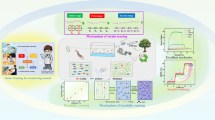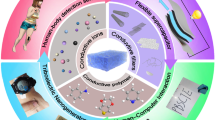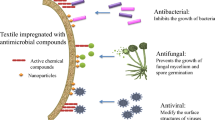Abstract
A graft-polymerization process with atomized lauryl methacrylate as monomer is used to fabricate fluorine-less and asymmetrically superhydrophobic cotton fabrics. The polymers synthesized in the process can form nanoscale hierarchical structures on the cotton surface, and the surface morphology can be controlled by choosing a suitable solvent or by varying the feeding quantity of the monomer mist stream. After applying the surface modification to cotton fabrics, an asymmetrically superhydrophobic surface is achieved without any additional nanosized particles, and the solvent damages on the cotton fabrics are controllable at a very low level. Surface characterization reveals that the modified side of the cotton fabric has laundering-durable and mechanically stable superhydrophobicity with a water contact angle of more than 150°, whereas the opposite inherits the hydrophilic property of pristine cotton fabric. The modified cotton fabrics are found to have medium-level water-absorbing ability between pristine cotton and PET fabrics, as well as good vapor transmissibility similar to pristine cotton fabric. These properties are of great significance in textile and medical applications.












Similar content being viewed by others
References
An QF, Xu W, Hao LF, Fu YS, Huang LX (2013) Fabrication of superhydrophobic fabric coating using microphase-separated dodecafluoroheptyl-containing polyacrylate and nanosilica. J Appl Polym Sci 128(5):3050–3056
Andou Y, Jeong JM, Hiki S, Nishida H, Endo T (2009a) Design of nanocomposites by vapor-phase assisted surface polymerization. Macromolecules 42(3):768–772
Andou Y, Jeong JM, Nishida H, Endo T (2009b) Simple procedure for polystyrene-based nanocomposite preparation by vapor-phase-assisted surface polymerization. Macromolecules 42(20):7930–7935
Ates ES, Unalan HE (2012) Zinc oxide nanowire enhanced multifunctional coatings for cotton fabrics. Thin Solid Films 520(14):4658–4661
Chen F, Zhang D, Yang Q, Yong J, Du G, Si J, Yun F, Hou X (2013) Bioinspired wetting surface via laser microfabrication. ACS Appl Mater Inter 5(15):6777–6792
Conder JM, Hoke RA, Wolf WD, Russell MH, Buck RC (2008) Are PFCAs bioaccumulative? A critical review and comparison with regulatory criteria and persistent lipophilic compounds. Environ Sci Technol 42(4):995–1003
Deng B, Cai R, Yu Y, Jiang HQ, Wang CL, Li JA, Li LF, Yu M, Li JY, Xie LD, Huang Q, Fan CH (2010) Laundering durability of superhydrophobic cotton fabric. Adv Mater 22(48):5473–5477
Eadie L, Ghosh TK (2011) Biomimicry in textiles: past, present and potential. An overview. J R Soc Interface 8(59):761–775
Fouda MMG, Abdel-Halim ES, Al-Deyab SS (2013) Antibacterial modification of cotton using nanotechnology. Carbohyd Polym 92(2):943–954
Ganesh VA, Raut HK, Nair AS, Ramakrishna S (2011) A review on self-cleaning coatings. J Mater Chem 21(41):16304–16322
Hao LF, An QF, Xu W (2012) Facile fabrication of superhydrophobic cotton fabric from stearyl methacrylate modified polysiloxane/silica nanocomposite. Fiber Polym 13(9):1145–1153
Hebeish A, Mehta P (1968) Cerium-initiated grafting of acrylonitrile onto cellulosic materials. J Appl Polym Sci 12(7):1625–1647
Ivanova NA, Philipchenko AB (2012) Superhydrophobic chitosan-based coatings for textile processing. Appl Surf Sci 263:783–787
Li S, Zhang S, Wang X (2008) Fabrication of superhydrophobic cellulose-based materials through a solution-immersion process. Langmuir 24(10):5585–5590
Liang J, Zhou Y, Jiang GH, Wang RJ, Wang XH, Hu RB, Xi XG (2013) Transformation of hydrophilic cotton fabrics into superhydrophobic surfaces for oil/water separation. J Text I 104(3):305–311
Liu KS, Jiang L (2012) Bio-inspired self-cleaning surfaces. Annu Rev Mater Res 42:231–263
Liu XD, Nishi N, Tokura S, Sakairi N (2001) Chitosan coated cotton fiber: preparation and physical properties. Carbohyd Polym 44(3):233–238
Liu Y, Tang J, Wang R, Lu H, Li L, Kong Y, Qi K, Xin JH (2007) Artificial lotus leaf structures from assembling carbon nanotubes and their applications in hydrophobic textiles. J Mater Chem 17(11):1071–1078
Liu XJ, Liang YM, Zhou F, Liu WM (2012a) Extreme wettability and tunable adhesion: biomimicking beyond nature? Soft Matter 8(7):2070–2086
Liu YY, Xin JH, Choi CH (2012b) Cotton fabrics with single-faced superhydrophobicity. Langmuir 28(50):17426–17434
Liu KS, Tian Y, Jiang L (2013) Bio-inspired superoleophobic and smart materials: design, fabrication, and application. Prog Mater Sci 58(4):503–564
Luzinov I, Minko S, Tsukruk VV (2004) Adaptive and responsive surfaces through controlled reorganization of interfacial polymer layers. Prog Polym Sci 29(7):635–698
Ma Y, Cao X, Feng X, Ma Y, Zou H (2007) Fabrication of super-hydrophobic film from PMMA with intrinsic water contact angle below 90. Polymer 48(26):7455–7460
Ma WS, Zhang DQ, Duan Y, Wang H (2013) Highly monodisperse polysilsesquioxane spheres: synthesis and application in cotton fabrics. J Colloid Interface Sci 392:194–200
Marmur A (2004) The lotus effect: superhydrophobicity and metastability. Langmuir 20(9):3517–3519
Marmur A (2008) From hygrophilic to superhygrophobic: theoretical conditions for making high-contact-angle surfaces from low-contact-angle materials. Langmuir 24(14):7573–7579
Miao H, Bao FF, Cheng LL, Shi WF (2010) Cotton fabric modification for imparting high water and oil repellency using perfluoroalkyl phosphate acrylate via gamma-ray-induced grafting. Radiat Phys Chem 79(7):786–790
Ogihara H, Xie J, Okagaki J, Saji T (2012) Simple method for preparing superhydrophobic paper: spray-deposited hydrophobic silica nanoparticle coatings exhibit high water-repellency and transparency. Langmuir 28(10):4605–4608
Periolatto M, Ferrero F, Montarsolo A, Mossotti R (2013) Hydrorepellent finishing of cotton fabrics by chemically modified TEOS based nanosol. Cellulose 20(1):355–364
Roy D, Semsarilar M, Guthrie JT, Perrier S (2009) Cellulose modification by polymer grafting: a review. Chem Soc Rev 38(7):2046–2064
Shahid ul I, Shahid M, Mohammad F (2013) Green chemistry approaches to develop antimicrobial textiles based on sustainable biopolymers—a review. Ind Eng Chem Res 52(15):5245–5260
Shateri-Khalilabad M, Yazdanshenas ME (2013) Bifunctionalization of cotton textiles by ZnO nanostructures: antimicrobial activity and ultraviolet protection. Text Res J 83(10):993–1004
Shi YL, Wang YS, Feng XJ, Yue GR, Yang W (2012) Fabrication of superhydrophobicity on cotton fabric by sol-gel. Appl Surf Sci 258(20):8134–8138
Shin B, Lee K-R, Moon M-W, Kim H-Y (2012) Extreme water repellency of nanostructured low-surface-energy non-woven fabrics. Soft Matter 8(6):1817–1823
Shirtcliffe NJ, McHale G, Newton MI (2011) The superhydrophobicity of polymer surfaces: recent developments. J Polym Sci, Part B: Polym Phys 49(17):1203–1217
Sparks BJ, Hoff EFT, Xiong L, Goetz JT, Patton DL (2013) Superhydrophobic hybrid inorganic-organic thiol-ene surfaces fabricated via spray-deposition and photopolymerization. ACS Appl Mater Inter 5(5):1811–1817
Suja F, Pramanik B, Zain S (2009) Contamination, bioaccumulation and toxic effects of perfluorinated chemicals (PFCs) in the water environment: a review paper. Water Sci Technol 60(6):1533–1544
Wan SJ, Wang L, Xu XJ, Zhao CH, Liu XD (2014) Controllable surface morphology and properties via mist polymerization on a plasma-treated polymethyl methacrylate surface. Soft Matter 10(6):903–910
Wang XL, Hu HY, Ye Q, Gao TT, Zhou F, Xue QJ (2012) Superamphiphobic coatings with coralline-like structure enabled by one-step spray of polyurethane/carbon nanotube composites. J Mater Chem 22(19):9624–9631
Wenzel RN (1936) Resistance of solid surfaces to wetting by water. Ind Eng Chem 28(8):988–994
Wolfs M, Darmanin T, Guittard F (2013) Superhydrophobic fibrous polymers. Polym Rev 53(3):460–505. doi:10.1080/15583724.2013.808666
Xu LH, Zhuang W, Xu B, Cai ZS (2012) Superhydrophobic cotton fabrics prepared by one-step water-based sol–gel coating. J Text I 103(3):311–319
Xue ZX, Liu MJ, Jiang L (2012) Recent developments in polymeric superoleophobic surfaces. J Polym Sci, Part B: Polym Phys 50(17):1209–1224
Yang R, Asatekin A, Gleason KK (2012) Design of conformal, substrate-independent surface modification for controlled protein adsorption by chemical vapor deposition (CVD). Soft Matter 8(1):31–43
Yao X, Song YL, Jiang L (2011) Applications of bio-inspired special wettable surfaces. Adv Mater 23(6):719–734
Yin YJ, Wang CX, Shen QK, Zhang GF, Galib CMA (2013) Surface deposition on cellulose substrate via cationic SiO2/TiO2 hybrid sol for transfer printing using disperse dye. Ind Eng Chem Res 52(31):10656–10663
Yoon H, Buckley A (1984) Improved comfort polyester part I: transport properties and thermal comfort of polyester/cotton blend fabrics. Text Res J 54(5):289–298
Yu M, Wang ZQ, Liu HZ, Xie SY, Wu JX, Jiang HQ, Zhang JY, Li LF, Li JY (2013) Laundering durability of photocatalyzed self-cleaning cotton fabric with TiO2 nanoparticles covalently immobilized. ACS Appl Mater Inter 5(9):3697–3703
Zhang M, Wang CY (2013) Fabrication of cotton fabric with superhydrophobicity and flame retardancy. Carbohyd Polym 96(2):396–402
Zhang M, Wang SL, Wang CY, Li J (2012a) A facile method to fabricate superhydrophobic cotton fabrics. Appl Surf Sci 261:561–566
Zhang YL, Xia H, Kim E, Sun HB (2012b) Recent developments in superhydrophobic surfaces with unique structural and functional properties. Soft Matter 8(44):11217–11231
Zhang GW, Hu JW, Liu GJ, Zou HL, Tu YY, Li F, Hu SY, Luo HS (2013a) Bi-functional random copolymers for one-pot fabrication of superamphiphobic particulate coatings. J Mater Chem A 1(20):6226–6237
Zhang M, Wang CY, Wang SL, Li J (2013b) Fabrication of superhydrophobic cotton textiles for water–oil separation based on drop-coating route. Carbohyd Polym 97(1):59–64
Zhang XX, Wang L, Levanen E (2013c) Superhydrophobic surfaces for the reduction of bacterial adhesion. RSC Adv 3(30):12003–12020
Zhou X, Zhang Z, Xu X, Guo F, Zhu X, Men X, Ge B (2013a) Robust and durable superhydrophobic cotton fabrics for oil/water separation. ACS Appl Mater Inter 5(15):7208–7214
Zhou X, Zhang Z, Xu X, Men X, Zhu X (2013b) Fabrication of super-repellent cotton textiles with rapid reversible wettability switching of diverse liquids. Appl Surf Sci 276:571–577
Acknowledgments
This work was financially supported by the Natural Science Foundation of Zhejiang Province (LY12E03007), the Scientific Research Foundation for the Returned Overseas Chinese Scholars, the State Education Ministry (1101603-C).
Author information
Authors and Affiliations
Corresponding author
Electronic supplementary material
Below is the link to the electronic supplementary material.
Rights and permissions
About this article
Cite this article
Wang, L., Xi, G.H., Wan, S.J. et al. Asymmetrically superhydrophobic cotton fabrics fabricated by mist polymerization of lauryl methacrylate. Cellulose 21, 2983–2994 (2014). https://doi.org/10.1007/s10570-014-0275-6
Received:
Accepted:
Published:
Issue Date:
DOI: https://doi.org/10.1007/s10570-014-0275-6




